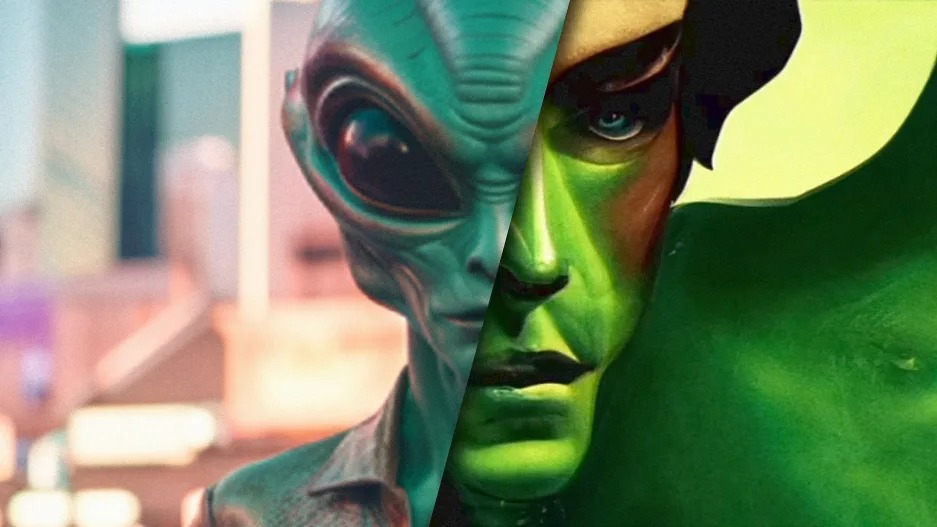- | 8:00 am
Why Marvel’s ‘Secret Invasion’ title sequence doesn’t spell the end of VFX
Marvel uses generative AI in a title sequence; Stable Diffusion gets easier to use; and a sci-fi trope comes to life in this week’s roundup of AI creativity.

It finally happened: Generative artificial intelligence was used for the first time in a big-time Marvel production. Last week during the premiere of Secret Invasion, Samuel L. Jackson’s new Marvel series on Disney+, viewers got a glimpse of AI-generated artwork in the title sequence. Naturally the peanut gallery is up in arms about it, screaming like banshees because they think it looks terrible and represents the end of visual effects and human artistry.
They’re right—it does signal the end of VFX, but they’re not right about why.
While the title sequence does have that typical AI-nightmare aesthetic, it was styled that way on purpose. As Polygon reports, the title sequence was made by Method Studios, a visual effects outfit that has worked with Marvel in the past. And it took a lot more than writing the prompt “Make me a green title sequence with aliens and stuff.” Method Studios wanted to use AI because it was on point with the themes in the show, which deals with the idea of not being able to trust what you see. In fact, the VFX house specifically told The Hollywood Reporter that “AI is just one tool among the array of tool sets our artists used. No artists’ jobs were replaced by incorporating these new tools.”
Will generative AI do away with visual effects as we know them? Of course it will. And as Cameron Adams, Canva’s chief product officer, told me in a video interview last week, it will allow a lot more human creativity to bloom—both by lowering the bar of entry for people who have a story to tell but no skills or budget to do so, and by raising the bar for professionals to produce even more amazing content that doesn’t look as bad as Ant-Man and the Wasp: Quantumania.
SDXL IS GETTING CLOSE TO FINAL RELEASE
Let’s talk about the latest version of SDXL. It’s been only three months and the more accurate, easier-to-use version of Stable Diffusion just got a lot better. Stability AI keeps training the model and it gets markedly better with each new version.

According to the company, it produces “massively improved image and composition detail and is a leap in creative use cases for generative AI imagery, including hyperrealistic creations for films, television, music, and instructional videos, as well as for design and industrial use.” It claims it has the largest parameter counts of any open-source model (up to 5.2 billion combining all the models available) and it can run on a pretty standard Windows PC. You can also use it on the Clipdrop platform right here.

What’s more exciting is what a company spokesperson told me over an email interview: After Stability releases the open-source 1.0 version in mid-July, developers will be able to integrate it “in a wide range of imaging applications, from video to animation to 3D.” Which means we will have them in our hands, in easy-to-use professional and consumer software, probably before the year ends. The spokesperson also said that both SDXL and Deep Floyd—its typesetting and compositing AI platform—“will form the basis for our suite of imaging models in the near term with continued developments going forward.”
ALPHASIGNAL IS NEXT-LEVEL SCI-FI AI
A group of researchers has been able to reconstruct what a person was seeing in 3D by analyzing the reflection in a human eye using artificial intelligence. Yes, the cliche of many a B-level sci-fi crime movie is actually one step closer to becoming reality.
From the paper: “We train the radiance field on the eye reflections by shooting rays from the camera, and reflecting them off the approximated eye geometry. To remove the iris from showing up in the reconstruction, we perform texture decomposition by simultaneously training a 2D texture map that learns the iris texture.” Translation: This technology is constructing a NeRF—a neural radiance field that allows AI to take images and turn them into a full 3D scene—just by looking at someone’s eyes.
Cue in the Black Mirror intro theme. Indeed, the times they are a changin’.







































